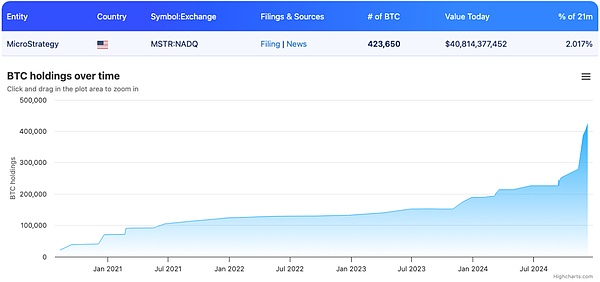
Source: Liu Jiaolian
Overnight BTC sought support from the 5-week line near 96k. In the early morning, Microsoft shareholders' vote on BTC reserves failed, which was expected by the market. MicroStrategy has added positions again. Michael Saylor posted:
"MicroStrategy has purchased 21,550 BTC at a total price of approximately US$2.1 billion, with an average price of approximately US$98,783 per coin. The cumulative quarterly BTC-based return rate reached 43.2 %, and the year-to-date return rate is 68.7%. As of December 8, 2024, MicroStrategy holds 423,650 BTC, and the total purchase cost is approximately. 25.6 billion US dollars, the average price is about 60,324 US dollars per coin "
Netizen Fred Krueger analyzed the micro-strategy strategy of adding positions:
< p>At the beginning of November: MicroStrategy held 252,000 BTC. BTC price 69k. MicroStrategy's stock price is 2.1 times its net assets per share.MicroStrategy formulated a plan to increase its position by 171,000 BTC, an increase of 68%. A total of US$160 was spent, of which US$3 billion was raised from the US stock market through convertible bonds. In the end, MicroStrategy’s share price successfully increased to 2.4 times the net assets per share.
Mathematical magic: Due to the high average net asset multiple (2.9x) and the use of convertible bonds, this plan to increase BTC holdings by 68% only resulted in the issuance of 40 million new shares (an increase of 17 %). Check: 1.68 / 1.17 = 43% Q4 return (as stated).
Summary: MicroStrategy spent $16 billion and boosted earnings per share by a staggering 43%.
Teacher’s note: Fred Krueger wrote 40k in the number of new shares issued. Jiaolian suspects that he made a clerical error and may have written 40M, because as of December 2024, the total circulating capital of MicroStrategy is approximately 230 million shares). Another thing worth complaining about is that when searching the Internet for the total share capital of MicroStrategy, I can't find a reliable figure. The figures given by various financial websites are different. Whenever we delve into these details, we will silently become more convinced in our hearts that blockchain and digital assets will definitely replace these old financial systems in the future. These old systems make it difficult for retail investors to understand even a single number, and there is no method for open, transparent and credible verification. It's almost doubtful whether it was intentionally vague. Because of the quantity issue, it is the most critical number for manipulating additional issuance and dilution. Anyone who has been exposed to the blockchain token economy understands that one of the most important top-level designs of the token economy is the total amount and additional issuance method.
Back to the topic. Then, Fr.Ed Krueger proposed a new unit of measurement for BTC: 1 Nakamoto, equal to 1.1 million BTC - this is the number of BTC suspected of being mined by Satoshi Nakamoto in his early years.
In the past, the smallest unit of the original BTC chain was one BTC in 100 million, which was called 1 satoshi. Now we can have a relatively large currency hoarding unit, 1 Satoshi Nakamoto is equal to 1.1 million BTC.
We know that just a few days ago, the total holdings of the US spot BTC ETF just exceeded 1 Satoshi Nakamoto.
Fred Krueger calculated that if Michael Saylor tried to let micro-strategy hoard BTC to reach the amount of 1 Satoshi Nakamoto, there would still be a shortfall of 676,350 BTC. Based on the current price of 96k, it will cost approximately US$64.9 billion. This is four times the previous $16 billion.
Learning from the past, gold-backed banknotes were all about a “gold content.” Now that BTC is used to back stocks, they can have a “sat content,” that is, how many satoshis are supported by BTC behind each share.
Based on the current micro-strategy holding 423,650 BTC after the recent increase in positions, and the total share capital after the issuance will become approximately 230 million plus 40 million new shares, which is equivalent to approximately 270 million shares, the content of each share is:
423650 / 2.7 = 157,000 Satoshi/share
If MicroStrategy can still raise another 4 times the amount of U.S. dollars with the same financing efficiency and increase its holdings to 1 Satoshi, then the holdings will increase to 1.1 million BTC, and the total equity Expanded to 430 million shares, the content of each share will be increased to:
1100000 / 4.3 = 256,000 satoshis/share
Having counted it up to this point, I wonder if readers have noticed that according to the micro strategy, although it has been diluting by issuing additional shares, it has exchanged all the dollars raised from the additional issuance. Becoming BTC, on the contrary, the content of each stock has increased. If we are optimistic about the value growth of BTC in the long term, this means that the value of each share of the micro strategy has also been greatly improved through this operation.
Of course, this calculation is too idealistic. First of all, it is a question whether micro-strategies can continue to raise funds from the US stock market at high premiums. Secondly, if the micro-strategy keeps buying like this, then the price of BTC will never stay at 96k and wait for it to slowly increase its position. In other words, firstly, it may not be able to successfully raise so much money, and secondly, even if it raises money, it may not be able to buy so many BTC at a low price.
Despite this, the micro-strategy still achieved the strategic purpose of hoarding a large amount of BTC by taking advantage of the flooding US dollar liquidity in the US stock market. This clever use of the situation is really amazing.













